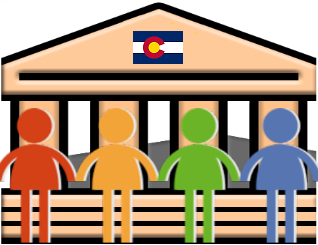Addressing a Major Problem –With Local Solutions
Colorado is facing economic challenges that national and international financial institutions, because of their private ownership and structure, are not addressing. Rather than demonizing these institutions, Rocky Mountain Public Banking Institute (www.bankingoncolorado.org) applies the principle “Think globally, act locally” to this issue. We understand that these great banks are hurting local economies everywhere, but that local action has the best prospect to provide immediate relief to our own local communities. Given enough of these local actions, we will see global relief. To this end we will provide a full range of educational support for efforts to establish public banks at the city, county, and state level in Colorado. The justifications for this action are given in the following sections.
What is a Public Bank?
A public bank is a bank that is controlled by and principally funded by a government body rather than by private investors. In essence, it is an extension of the governing body that created it — state, county, or city government. The governing body for the bank deposits all its revenue, taxes, fees, and other earnings, in the bank. In addition, it can borrow from their bank. The officers of the bank report to a board or commission defined by the charter of the bank so as to ensure freedom from conflicts of interest, commitment to follow sound banking principles, and service to the public interest. Further, a public bank does not pay exorbitant salaries and bonuses, and they have no advertising, no branches, no tellers, or ATMs, and they do not pay commissions or fees, making it very sound financially. .
Public banking is common around the world, particularly in developing and newly-developed countries. Globally, about 20 percent of banks are publicly owned. The countries with public banks mostly survived the Great Recession of 2008.
Public banking has also played an important role in America’s past. The U.S. Post Office ran the Postal Savings System from 1911 to 1967. This brought affordable banking services within reach of all Americans. There is currently a movement to reinstate a Post Office Bank — to allow the growing number of unbanked Americans access to banking services.
Public banking has gained new respect in the wake of widespread, ongoing problems with America’s major banks. There is widespread belief that the banking industry has deep structural flaws that have not been fixed and probably cannot be fixed, given the industry’s influence in Washington. There is the desire to build new and better banking institutions that can operate reliably for benefit of all American consumers and small businesses.
How a Public Bank benefit its constituents?
Public banks can be chartered and managed so they support local lending within the jurisdiction in which they operate. While existing public banks and those currently proposed generally do not lend directly consumers and businesses, they can either co-lend with a private community bank or purchase loans made by community banks, allowing those banks to make additional loans that benefit the local economy. Investment is within the governing community, maximizing public good within that community rather than maximizing profits through global investment strategies.
There are exceptions to the policy of not lending directly where it is viewed as directly beneficial to their constituents. For example, the Bank of North Dakota has been authorized by the state to make low-interest-rate loans to students, which they rightly view as beneficial to the state.
One very important effect of the support of community banks is that, because they are a part of the community they fund, they are much less inclined to foreclose on delinquent loans but lean more toward negotiating restructured loans that can be repaid.
An interesting aside is that by chartering public banks, the U.S. banking system would be, in part, returning to a banking model closer to the state-level system that was more prevalent before the major deregulation of the banks was passed in 1999, which included the repeal of the Glass-Steagall Act of 1933. Glass-Steagall had required a clear separation of banking operations from risky investment banking operations, and from insurance and brokerage firms. The repeal of Glass-Steagall allowed mergers of already huge banks, insurance companies, investment banks, and brokers—greatly increasing the risk to banking depositors and to our financial system, contributing heavily to the collapse of 2008.
Public banks would be prohibited from speculating in risky derivatives. This would help prevent economic collapse and the need for bailouts that burden the taxpayer. Further, because of our fractional reserve banking system, public banks multiply the money loaned for economic development and infrastructure, up to ten dollars in loans for local interests for each dollar of capital reserves of the bank.
Like a private bank, a public bank charges interest to borrowers, which generates earnings. Since it does not pay dividends or seek to maximize profits for outside investors, which a private bank must do, it can charge lower interest rates to serve borrower’s needs and facilitate their ability to pay, and its earnings all inure to the benefit of the community.
For further information, we invite you to view the following two videos. The first gives a general view of the structure and benefits of public banking. The second looks specifically at the Bank of North Dakota.
An Introduction to State Banks
The Bank of North Dakota
